in the Worlds of Power
Notes
about Presentations & Presentors
-----------------------------------
Aras Ozgun
-----------------------------------
Creative Industries: Neo-Liberalism as
Mass Deception
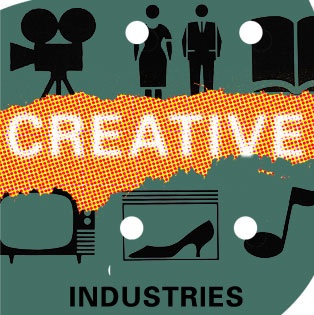
In the past few years, we have observed the emergence of a
new political discourse/program which quickly became influential
in cultural policy making and public debates concerning the
cultural production. This discourse defines the field of cultural
production as primarily an economic field –by calling
it as “creative industries”, and often times appear
as an economic development (or “survival”) program
at a practical level. But this pragmatism is actually a pseudo-scientific
disguise for the substantially political nature of the discourse,
which brings a practical imposition of a neo-liberal governmentality
by intending to restructure cultural field through economic
principles, assign the cultural producers an “entrepreneurial
role”, redefine the “creative process” itself
and paradoxically bring the appropriational logic of capitalist
economy to the necessarily collective practice of cultural
production. What I intend to do in this presentation is to
develop a critique of such discourse at a political level,
and investigate it as a "bio-political intervention".
-----------------------------------
Ava Bromberg
-----------------------------------
“What about those little brown clusters, aren’t they
villages?” “Don’t worry about those. Just show
us your ideas.” – Some reflections
of Master Planning Cities in China
I recently returned from six weeks working in a large Chinese
Urban Planning firm and think tank in Shenzhen, P.R.C. For this
year’s continental drift, I will draw upon my experience
working on two major master planning projects – a factory
town and a new airport city - to present the context for planning
in China. My aim is to give a sense of the scale and pace of planning
there, what is being built and what is being overlooked. In addition
to drawing from what I learned and gleaned on the job, I will
share some images and reflections on the human and social environments
of Shenzhen – a city that developed from a village of 20,000
to a city of 10 million in the last 20 years. I hope a my presentation
on Chinese urbanization processes (and my sense of where the crack
and the opportunities are) can set us up to think broadly and
deeply about what the interpenetrating (and co-productive) relationship
between microenvironments and macroprocesses offers us for “articulating
the cracks” in existing systems.
Question:
I have a favorite John Friedmann quote that is illustrative
of my starting point, and how I choose to enter into this larger
project to transform social relations that many of us are engaged
in: "Without vision, no radical practice; without radical
practice, no theory; without theory, no strategy; without strategy,
no action."
I like this Friedmann quote because it acknowledges the need for
vision-->on the way to-->action. Vision, in my opinion,
is crucial to the radical reconstitution of existing social/spatial/economic/political
structures - we have to know where we’re headed if we want
to figure out how to get there. I feel an urgency to ask not only
what kind of spaces for developing vision (and values outside
of profit-maximization) are available *right now*, but also how
are they opened up and extended to "ordinary" people?
What are some concrete examples? And/or some concrete possibilities?
What types of spaces (physical and discursive) do they occupy
/create? How do these spaces ‘operate’ and what is
their role in the production and diffusion of social forms outside
of capitalism?
Being personally, intellectually, and creatively (and in every
other way) invested in each of these "phases" - vision,
radical practice, theory, strategy, and action, we know that the
critique is not enough. It is just the beginning. We draw from
our micro-practices and experiments. And our critical analysis
shows us *how* to (and that we must) move towards a vision of
the world we want. But where (what sites) and by whom (which agents)
will this vision - and the values it produces and is produced
by - be developed? How might we more equitably distribute the
opportunity for people to develop vision (and their potential)
outside of capital markets?
-----------------------------------
Ayreen Anastas & Rene Gabri
-----------------------------------
Over the last year we have embarked on a wide reaching
and ambitious journey aided by some very simple set of concerns/questions
and an interest in changing the current political circumstances.
We started by wanting to address the untenable situation facing
the the detainees (and their families) held in Guantanamo Bay.
Rather than view this as an exceptional case; however, we felt
it was important to see how this"anomolous" camp shapes,
underlines and conditions the norm.
To help start the process we began with a simple question, which
is "How is it that a camp* like Guantanamo Bay can exist
in our time?" This question is in some respects naîve,
simple, or even rhetorical - but what it operates as for us -
is a kind of trigger - to connect the circumstances that the detainees
are facing in Guantanamo Bay, particularly in relation to the
law, with others that may be much closer to the everyday life
of people, whether in the US or in other countries.
Our research, our collaborations and discussions with specific
individuals as well as our attempts to make some necessary connections
landed us in the Middle East of Baltimore as well as Occupied
Palestine and Israel. These became for us two particular cases
in which the law applies by disapplying itself. Moreover,
in each case, this exceptional relation to the law had specific
spatial practices associated with it, which opened up our understanding
of the camp as a paradigm of modern governance.
In these specific cases, a group of individuals is "targetted"
as dangerous or threatening to a particular program or posited
way of life. These targetted groups are then subsequently limited
in their movement, their way of life, and to greater or lesser
degree imprisoned, stripped of the basic rights afforded by the
state or even international law.
Building further from these specific inquiries, this summer we
embarked on a trip through the United States attempting to connect
these three brutal instances (guantanamo, baltimore, palestine/israel)
to recent and not so recent events in the US (e.g., Kent State
massacres, former POW camps, internment camps for Japanese, Germans,
and Italians, boot camps for youth, pre and post Katrian New Orleans,
Native American reservations, high security prisons, ... ).
Our trip had elements of a research project and a campaign, but
contained within it gestures, contacts, aesthetic moves, public
interfaces and interventions, which unsettled even our notions
of a so-called "artistic project" or "political
project."
We hope to give a short presentation and to talk about where to
locate our inquiries in relation to the paradigm of camp and the
state of exception within our larger inquiries under the heading
of Continental Drift.
Question:
How is it that a camp* like Guantanamo Bay can exist in our time?
How can we connect this exceptional relation to the law (faced
by the internees) to other situations, unfolding in detainment
centers throughout the world, in the so-called "conflict
in the middle east," and in our cities? What can we learn
from these instances and how can we work with or use these insights
within our politics, our political activity?
*internment, concentration, torture, death, political prisoners,
pow, ...
-----------------------------------
Concerned Subject
-----------------------------------
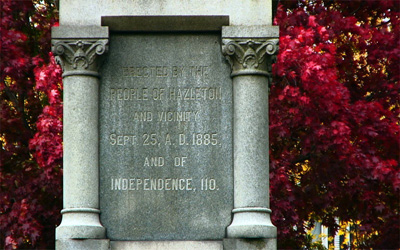
Hazleton, PA
Two months ago the town of Hazelton, PA, passed the most aggressive
anti-immigration legislation ("Illegal Immigrant Relief Act)
in the United States, instituting harsh penalties for any employer
or landlord having business dealings with undocumented workers,
as well as declaring English the official language of the town
and forbidding the translation of any official document into another
language. These laws are a test case for 10 other municipalities
that have followed to pass similar statutes and 32 towns or counties
that are considering doing so. In a broader sense, it pertains
to immigration reform in the US, immigration patterns into smaller
cities, exurbs, and rural areas, and to projects seeking productive
possibilities for local struggles in the face of right-wing populisms.
The project is a public media and cultural campaign against this
legislation. To do this, I hope to use a well-known fictive character
to demonstrate the true ramifications of the current "zero
tolerance" law. Namely, one of America's most-loved undocumented
workers will not be able to visit this year (Santa Claus). The
project will involve print advertising, viral video, an email/fax
press release campaign, and a public performance. Due to a recent
visit, ongoing research, and dialogue with groups opposing the
legislation, as well as local citizens of all stances, my understanding
of when or how the project should be deployed is still developing,
Santa may not be the right direction to go with it. [Laws were
scheduled to take effect today, but a federal Judge in Philadelphia
just issued a 14-day restraining order today]:
http://hosted.ap.org/dynamic/stories/P/ PA_ILLEGAL_IMMIGRANTS_CRACKDOWN_PAOL-?SITE=PASUN&SECTION=ASIA&TEMPLATE=DEFAULT
Potential
Readings:
These are factual more than theoretical and not directly about
the town's legislation, but potentially informative to our discussion
(if limited by their specificity to the US):
From
Monthly Review:
"Harder Times: Undocumented Workers and the US Informal Economy"
By Richard D. Vogel
http://www.monthlyreview.org/0706vogel.htm
From
Dollars&Sense:
"The Rise of Militant Migrancy"
by Immanuel Ness
http://www.dollarsandsense.org/archives/2006/0906ness.html
Question: How can we conceive of local struggles
in a productive manner within the context of what we are calling
Continental Drift? What strategies can be used to communicate
or translate this to populations where the immediacy or urgency
of these struggles on a local level may initially be disruptive
to understandings of larger patterns and shifts. The underlying
question is not so much one which seeks to maintain a notion of
the local in the global, but really a pragmatic one involving
how a field of action or involvement
-----------------------------------
campbaltimore
-----------------------------------
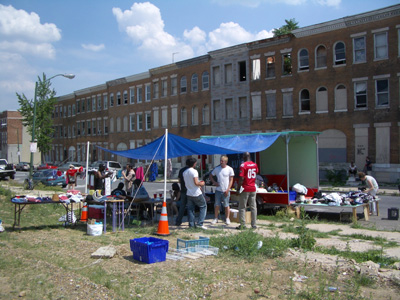
campbaltimore is an ongoing project based on research, communication
and organizing with a commitment to building solidarities between
different groups and individuals working for social justice. Its
participants share an interest in understanding, confronting and
changing the structural causes of socio-economic inequality in
Baltimore and abroad. campbaltimore will share information about
the current conditions of uneven development and socio-economic
inequality in Baltimore and present documentation of projects
and experiments that respond to these conditions through tours,
social gatherings, educational programs, screenings, a newspaper
publication and interventions in public space.
Questions
1. How can multiple groups working on different issues
and initiatives recognize their common struggles? How can they
form networks or coalitions to communicate and share resources
while retaining their individual autonomy?
2. How can we produce experimental times and spaces that contribute
to the formation of such relationships and solidarities?
3. How can we work within cultural and academic institutions while
resisting forms of co-optation? How can we build sustainable practices
outside of these
institutions?
4. How can we link local struggles against neoliberal urban redevelopment,
gentrification, the privatization of public housing, the creation
of ghettos, police
repression and the prison industrial complex with the global social
movements against neoliberalism
-----------------------------------
Claire Pentecost
-----------------------------------
I would like to lay out some problematics and assay a few experimental
principles for "how to be political" in our time. As
a springboard I will respond to a couple of points in Melinda
Cooper's essay "Pre-empting Emergence," and also connect
thoughts from: recent theorization of affect; my own research
in the politics of food; features of the work of Precarias La
Deriva, Laurie Palmer, and others. The idea is to provoke specific
outlines for inhabitable oppositional structures by venturing
specific operational positions. I hope to provide a structure
for a discussion which will engage the knowledge and experience
of people at 16Beaver this weekend, hopefully yielding working
tenets for ongoing and applied modification.
-----------------------------------
Daniel Tucker for AREA Chicago
-----------------------------------
AREA Chicago and Local Infrastructure Development
AREA Chicago is a biannual publication dedicated to researching
and networking the art, education, and activist practices within
the city of Chicago. A stated project goal is "to be a shared
space to fuel, debate, refine, express and implement our collective
goals for a more desirable and livable Chicago and world".
Always addressing complex topics through the lens of local grassroots
work, AREA Chicago has explored the themes of Privatization/Welfare
Cuts, Local Food Systems, and social movement Solidarity History
that connects local practice with the rest of the globe. Additionally,
AREA Chicago sponsors three related projects: "Infrastructure
Lecture Series" dealing with organizational/sustainability
issues of activist and cultural groups and the "Peoples Atlas
of Chicago: Sites of Relevance" mapping project which takes
the form of workshops designed to create subjective and nontraditional
maps of the city about different topics, and "AREA Books
Imprint" - our most recent side project launching next year.AREA
Regularly hosts and co-sponsors public events related to our contributors
practices throughout Chicago.
-----------------------------------
The Friends of William Blake
-----------------------------------
http://www.counterrecruitmentguide.org
As a counter argument to the grinding machine of military recruitment
during the Iraq War, fighting in Afghanistan, and elsewhere, a
small collective of artists, writers, activists (The Friends of
William Blake) have created The New Yorkers’ Guide to Military
Recruitment in the 5 Boroughs. This pocket-sized, sixty page book
is a comprehensive guide to local military recruitment and resources
for counter recruitment in NYC. Made in the spirit of The People's
Guide to the RNC which we published in ‘04, this book is
a small part in the worldwide effort for peace & justice and
is opposed to the growing climate of fear & increased militarism
in the USA.
The guide seeks to inspire hope while provoking conversation,
informing potential recruits, and giving activists a new wrench
in their toolbox. Features include: three “Soldier’s
Story” profiles of first Iraq War era troops, written from
our interviews, a “Narrative Thread” Harper’s
style index on recruitment and the war, informative disclosures
on military benefits, data about the military in schools, ROTC
& JROTC, borough maps showing location the ‘militarized
zones’ in New York’s neighborhoods. Legal resources,
media outlets, and counter-recruitment organizations are listed
and there is information on “how to create this book in
your community.”
Over 7500 copies of The New Yorkers’ Guide to Military Recruitment
in the 5 Boroughs have been distributed for free to students,
parents, counselors, potential recruits, concerned citizens and
activist organizations in the NY metro area, across the country
& internationally. This publication is copy-left.
-----------------------------------
iKatun
-----------------------------------
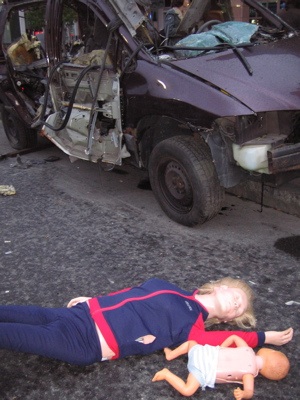
Image caption: Fake Dead People with Car Which Was Not Blown Up
By Terrorists. The car was blown up in the desert and shipped
to Kennedy Plaza in Providence to simulate a terrorist car bomb.
Pieces of the car were placed throughout the plaza to mirror where
they would have gone had the car really been blown up in the plaza
by terrorists and not in the desert by Alcohol, Tobacco and Firearms
agents
Question:
I'm not sure we have such a great question but here is
what I think we would be interested in hearing more about -- Where
is culture (and propaganda, manipulation, coercion through media)
in the discussions of continental drift? As iKatun, we are interested
in the ways that information is wielded to produce affect and
emotions that then seep into everyday life in the ways that we
vote, travel, eat, drink, play, work, etc.
Stand Up Stand Still
Stand Up Stand Still is a global participatory performance
organized by iKatun with Andi Sutton. The 50-hour performance
will invite people around the world to "stand up" in
various ways against the culture of fear on September 12th, 2007.
We want to talk briefly about what we mean by the culture of fear.
Then we will present the performance, how it will work, and pose
questions to gather feedback and ideas on how to make it happen
as widely as possible. This will be a short presentation/discussion.
-----------------------------------
Jesal Kapadia
-----------------------------------
Information forthcoming.
Talk will be related to a recent project which addresses the neoliberal
economics through outsourcing and a journey that goes from Texas
and New Jersey to Dubai and Bombay.
-----------------------------------
miss rockaway armada
-----------------------------------
http://www.missrockaway.org/
The Miss Rockaway Armada is a group of approximately 25 performers and artists from all over the country including members of the Toyshop Collective, Visual Resistance, The Amateurs, The Floating Neutrinos, The Infernal Noise Brigade, The Madagascar Institute and the Rude Mechanical Orchestra. This July we converged in Minneapolis to construct a flotilla of rafts that will journey down the Mississippi River. We’re stopping in towns along the way, hosting musical performances and vaudeville variety-theater in the evenings, along with workshops and skill-shares centered around arts and environmental issues during the day. In our travels we intend to share stories and to solicit dialogue around subversive and constructive ways of living. We are a group of intrepids who believe in a hands-on, live-by-example approach to creating change within our culture. We are taking cues from Johnny Appleseed, traveling medicine shows, nomadic jewel box theater, and of course that old radical Mark Twain.
-----------------------------------
Naeem Mohaiemen
-----------------------------------
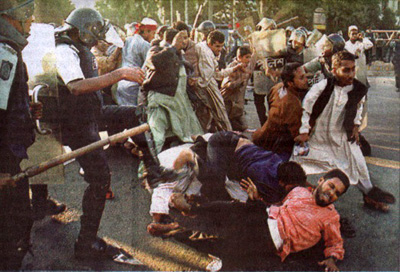
Hawthorne Effect and Muslims or Heretics: My Camera Can Lie?
When part of an audience that refuse directed activism ("this is what you should care about") and limited spheres of influence, the viewer becomes hyper-aware of other, future audiences. The unfortunate coincidence of screening this film at the same time as a global media flap over the Abu Ghraib images turned each screening into a referendum on US foreign policy. A Dhaka audience refused to give an "authenticity" blessing. Instead, their articulated counter-argument was that issues internal to Bangladesh, specific to a rightist Islamist agenda, could not be debated until US human rights abuses were addressed and remedied.
Naeem
Mohaiemen's other work can be seen at http://disappearedinamerica.org
-----------------------------------
Pedro Lasch
-----------------------------------
Indigenous Immigrants: overlapping resistances and analogous
exclusions
A
presentation of work done by various groups, individuals and organizations
that connect to both of these movements and with whom there is
already a common experience of drifting.
back